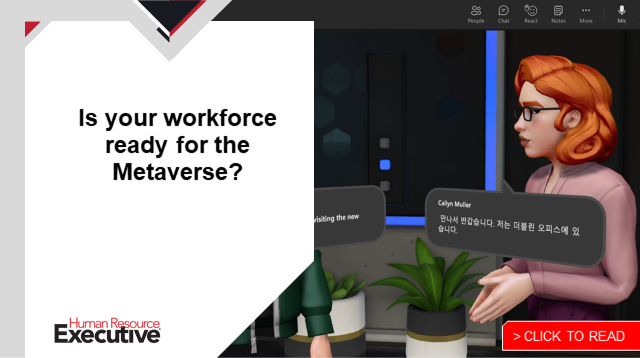Last month, we saw two interesting moves that will surely impact the employee listening segment of the HR tech market.
On Feb. 17, Microsoft announced its plan to expand Viva, its employee experience platform, by adding Glint tools to the suite. Glint tools help executives get detailed insights on employee engagement and skills that can then be used for resolving issues and making better decisions. Two days earlier, Perceptyx, a leading platform provider for employee listening and data analytics, announced the acquisition of Cultivate, a pioneer in AI-powered leadership development.
These two announcements demonstrate the importance of the employee listening market and its rapid evolution. I’ll give you my view of these deals later in this article, but first some background.
Once considered the domain of industrial psychologists and survey tools, employee listening is now one of the hottest spaces in HR tech. Pretty much every single company on the planet is trying to figure out how to better attract, develop, retain and engage its employees. I estimate that approximately 40% of companies now use some sort of pulse survey or open feedback system.
 Related: 10 themes from HR Tech Virtual to help you prepare for the coming decade
Related: 10 themes from HR Tech Virtual to help you prepare for the coming decade
Over recent years, we’ve also seen significant innovations in employee listening solutions. In particular, I’ve seen the market move through three stages:
- Employee listening 1.0: At this stage, tools were designed to administer employee surveys at fixed, regular intervals (think annual surveys). The same questions were usually asked year after year, since the primary purpose of these surveys was to provide benchmark data for managers.
- Employee listening 2.0: Next came the use of pulse survey tools, deployable via mobile devices, that could be administered as needed and provide immediate, analyzed feedback.
- Employee listening 3.0: Now, we’re seeing employee solutions that not only provide real-time employee feedback and sentiment analysis, sometimes from multiple sources, but they also “translate” this information into nudges, suggestions, and recommendations for actions and behavior changes for managers.
As described in my 2021 HR technology report, I see this market continuing to evolve in three ways:
- Solutions will collect data (or what I call “signals”) from multiple sources and in different formats. In addition to survey data, solutions will have the ability to analyze voice, text and email messages; website activity; and calendars. We’re starting to see the ability to analyze mood and sentiment and highlight the potential for burnout.
- Solutions are relying more and more on advanced analytics and AI to provide real-time responses, such as alerts, suggested actions and recommended microlearning. These innovations are all about reducing the time from “signal to action” and offering paths for immediate improvements.
- Finally, corporate buyers are seeing a flood of employee listening options, ranging from add-on solutions to new features being added to legacy solutions. As always, HR leaders will need to consider their options carefully, balancing their goals with available budget and compatibility with their existing tech infrastructure.
Now that I’ve set the stage, here is my view about the two recent announcements.
Microsoft Viva and Glint
 Microsoft Viva, a suite of tools designed to help employees connect, collaborate, learn and share, became generally available just last year. According to Microsoft, it already has 10 million paid users, 1,000 customers and more than 300 enterprise-class integrated applications. Viva is especially attractive for those companies already using Microsoft Office or Teams. The addition of Glint, which was acquired by Microsoft in 2018, gives Microsoft shops the ability to get an integrated enterprise survey and analytics platform without adding yet another vendor to their tech stack.
Microsoft Viva, a suite of tools designed to help employees connect, collaborate, learn and share, became generally available just last year. According to Microsoft, it already has 10 million paid users, 1,000 customers and more than 300 enterprise-class integrated applications. Viva is especially attractive for those companies already using Microsoft Office or Teams. The addition of Glint, which was acquired by Microsoft in 2018, gives Microsoft shops the ability to get an integrated enterprise survey and analytics platform without adding yet another vendor to their tech stack.
See also: Microsoft Viva-why it could be a ‘massive opportunity’ for HR execs
Viva users will be able to match Viva Insights data (showing, for instance, how much time an employee is spending in meetings) against direct employee feedback, engagement and suggestion data. The data scientists who analyze Glint data will be sitting next to the data scientists who access Viva Insights data. They’ll start to see what behaviors, meetings and other activities drive employee retention, improve diversity and contribute to wellbeing.
The addition of Glint will also vastly improve Microsoft Viva’s learning capabilities. Glint is not only a survey and listening system, it also delivers action plans and developmental recommendations. I expect that we’ll see Viva Learning making it easier than ever to “learn what you need to know.”
Perceptyx and Cultivate
Perceptyx, a long-time leader in this market, has been cranking. A few months ago, it acquired Waggl and CultureIQ, which brought with them capabilities for crowdsourcing and pulse survey management. The acquisition of Cultivate adds AI-enabled text and sentiment analysis, coaching, nudges and proactive feedback (sometimes called passive listening) to the company’s existing flagship products for enterprise surveys, real-time analytics and 360 feedback.
In recent years, our analysts have interviewed many Cultivate customers who have used the employee feedback collected by its solution to help managers improve. Essentially, Cultivate is an AI-enabled leadership coach, something we all could use in these times. For example, leaders can see how often they give recognition or provide feedback, whether they make too many ad-hoc meeting requests, or if they communicate or share opinions equally across their team.
 This acquisition clearly positions Perceptyx as a company to watch in the employee listening and EX market segments. It has more than 600 Global 2000 customers, revenue growth of over 50%, and a staggeringly high net promoter score of 73.
This acquisition clearly positions Perceptyx as a company to watch in the employee listening and EX market segments. It has more than 600 Global 2000 customers, revenue growth of over 50%, and a staggeringly high net promoter score of 73.
Read more insights from Josh Bersin here.
The deal also lays down the gauntlet for the emergence of action platforms, systems that not only listen but actually respond. As more employees work remotely, online or in deskless environments, we can’t rely solely on feedback from surveys or text comments. We need passive (AI-enabled) listening systems that give us feedback in the flow of work. Perceptyx now has an offering that does just this, making the company more relevant and interesting than ever.
With today’s current talent challenges and the political and economic uncertainties, employee listening has never been more important. I’m sure we’ll be seeing more innovation from vendors such as ServiceNow, Workday, Qualtrics, Medallia and many others as this market segment continues to heat.
As they say in the construction business, “watch this space.”
The post What recent acquisitions signal about the employee listening space appeared first on HR Executive.